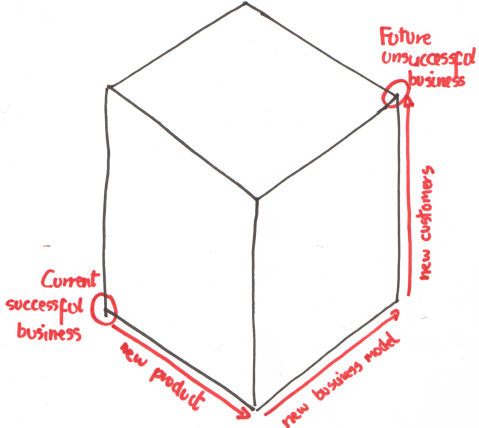Many of us will have come back after the Christmas break trying to think of new activities, new ideas and new opportunities for 2013. One of these is – is there some new product, proposition or market we could address, obviously with a view to expanding the addressable market, or creating new revenue streams?
Easy, surely? I’d suggest that getting this right is about the most difficult task for a marketing person. Why? Because there 1,000 factors that affect whether your new idea will fly or not, you can’t possibly hope to think of all of them, the ones you don’t think of could kill your proposition flat, and you might not be able to test the idea properly for some time. NB: I’m a big fan of failing fast with new ideas, but in the real world this is much easier said than done: can you truly test the viability of your product, till you’ve asked people to actually buy the thing?
Anyway, given this, what can you do to give yourself the best chance of success? From my experience of the last few years, your chances are increased considerably by reducing the number of perturbations from your core business, as much as you can.
By this, I mean that, for each new idea, you should consider how many different changes you are making to your core, successful business, with the new idea. The sorts of axes of change I’m thinking about are things like:
- The core product,
- The business model,
- The people you’re selling to,
- The type of customer you’re trying to reach,
- Region,
- Channels
And so on. Many of these have multiple sub-categories of course (e.g. business model covers many areas).
This issue is often described in product management circles as:
“Never propose a new product in a new market at the same time – do one or the other”.And this is a good summary. But why is this a good idea? If your current business is selling CDs online to UK end consumers, and some bright spark in your company proposes some brilliant new idea, “Why don’t we provide an online data translation service for East Asia – I’ve just read an article about a great opportunity out there!” then, yes, this might be a fantastic idea in the abstract, but you are almost certainly doomed to fail in your attempts to address it. Why? Fundamentally because you don’t know what you’re doing and the number of axes on which you are changing your model are so great that the number of unknowns will be overwhelming. In this example:
- The core product has changed from CDs to some new data service. How will this service work? What are the costs of running it? Do you have the skills to create this product?
- Business model – you’re currently set up to acquire CDs from somewhere, sell them online then send them out in the post. What do you know about selling a SaaS model? How do you reach these people? How do you even run a business like this – who are the employees you’ll need?
- It’s extremely unlikely anyone who might be interested in the new service will have heard of you, so your brand recognition is starting at zero.
- You’re currently selling to end customers, B2C. What do you know about a B2B model? And who are the buyers and users in your target companies? What’s the hierarchy? Who influences who?
- Region – UK vs East Asia. These are not the same.
- Channels – all of your current channels to customers will be obsolete.
And so on, ad infinitum.
One way of representing these changes is with a cube:
What this cube also hopes to represent as well, is the point about the significant increase in potential pitfalls from changing on so many axes. If, conservatively, there were 10 things that could kill your new idea when changing along any particular axis then, if you just changed one of these things (for example, you started selling CDs in the US as well as the UK), then there are 10 obstacles (some you’ll know at the start, some you won’t), which you’ll need to overcome to succeed. But, if you change 6 things (imagine a 6-dimensional hypercube!), then the number of things that can scupper you is 10^6, or 1 million! For example, it may be that the specific way that Japanese customers buy SaaS data services is regulated in some way that you could never guess, and you would have never found this until it was far too late.
This is, of course, a massive over-simplification, which is why the image at the top is of Dürer’s Solid (something more complex than a simple cube*). It’s not nearly as simple as each axis being equal and having the same impact. I would argue strongly that your chances of success if you’re selling something to the same group of people is much higher than if you’re trying to do anything with a new group of people. Even if you’re selling your wholly-unchanged product to a brand new group of people, none of those people know anything about you, they have no trust in you and it’s going to take considerable work to convince them otherwise. In contrast, a group of people who know you well and have had good service from you in the past, will always be interested in what you’ve got coming up next.
Of course, this all shouldn’t hold you back from trying to think of great ways of growing your business, but I now try and confine myself to twists on an existing business. Currently selling in the UK? Try selling in the US. Currently offering a perpetual license? Try selling a monthly subscription (to the exact same people for the exact same product). Or currently selling a version of your product to large banks? Try a version for the tier-2 smaller banks. And so on. Once you get headway in your new market, then push along a 2nd axis, starting from your new stronghold.
* I know the analogy with Dürer’s Solid is weak, but I’m such a fan of Dürer that I had to find some way of crowbarring it in
